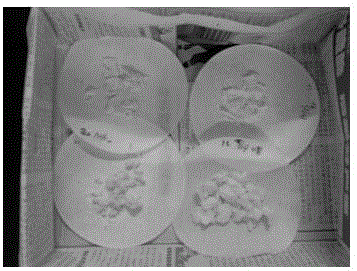Method for biosynthesis of hydroxybutyric acid and hydroxycaprylic acid co-polymer from sludge
A technology of hydroxyoctanoic acid and hydroxybutyric acid, applied in sludge treatment, biological sludge treatment, fermentation, etc., can solve the problems of unoptimistic economic benefits and low added value of products, and achieve the effect of resource recycling
- Summary
- Abstract
- Description
- Claims
- Application Information
AI Technical Summary
Problems solved by technology
Method used
Image
Examples
Embodiment 1
[0023] A method of sludge biosynthesis P (HB-HO), the method is:
[0024] (1) Each domestication cycle is 24 h, and the operation mode of each cycle is: water inflow + aerobic aeration + sludge discharge + sedimentation + water outflow; the inflow is simulated wastewater, and the inflow volume is 5 L; , the air compressor was used for aeration, and the aeration rate was kept at 2 L / min; a certain amount of activated sludge mixture was discharged before the aerobic aeration was stopped, so as to control the sludge concentration in the reactor to 2 g / L, Sludge concentration is calculated in MLSS; finally, the supernatant is discharged after sedimentation; the total time from stopping aerobic aeration to re-aeration does not exceed 20 minutes each time; samples are taken to measure MLSS, SVI, and pH before sludge discharge in each cycle When the above values are stable and the sludge color is yellow-brown, the sludge domestication is completed; about 2g / L, the SVI value is abou...
Embodiment 2
[0028] Temperature and pH were not controlled during acclimatization. Each domestication cycle is 12 hours, and the operation mode of each cycle is: water inflow + aerobic aeration + mud discharge + sedimentation + water outflow. The influent is simulated wastewater, and the influent volume is 4L; after the influent, the aeration pump is used for aeration, and the aeration rate is kept at 1.0 L / min; a certain amount of activated sludge is discharged before the aerobic aeration is stopped. liquid, to control the sludge concentration in the reactor to 1 g / L, and the sludge concentration is calculated as the suspended solids concentration of the mixed liquor; finally, the supernatant is discharged after precipitation. It is advisable that the total time from stopping aerobic aeration to re-aeration should not exceed 30 minutes each time. Sampling and measuring indicators such as MLSS and SVI are taken before sludge discharge in each cycle. When the above values are stable and ...
Embodiment 3
[0032](1) Each domestication cycle is 24 hours, and the operation mode of each cycle is: water inflow + aerobic aeration + sludge discharge + sedimentation + water outflow; the inflow is simulated wastewater, and the inflow volume is 5 L; , the air compressor was used for aeration, and the aeration rate was kept at 2 L / min; a certain amount of activated sludge mixture was discharged before the aerobic aeration was stopped, so as to control the sludge concentration in the reactor to 2 g / L, Sludge concentration is calculated in MLSS; finally, 5 L of supernatant is discharged after sedimentation; the total time from stopping aerobic aeration to re-aeration does not exceed 30 min each time; samples are taken to measure MLSS and SVI before sludge discharge in each cycle , pH value and DO, when the above values are stable, when the sludge color is yellowish brown, the sludge domestication is completed; about 2g / L, the SVI value is about 65, and the sludge age is 5d.
[0033] (2) A...
PUM
 Login to View More
Login to View More Abstract
Description
Claims
Application Information
 Login to View More
Login to View More - R&D
- Intellectual Property
- Life Sciences
- Materials
- Tech Scout
- Unparalleled Data Quality
- Higher Quality Content
- 60% Fewer Hallucinations
Browse by: Latest US Patents, China's latest patents, Technical Efficacy Thesaurus, Application Domain, Technology Topic, Popular Technical Reports.
© 2025 PatSnap. All rights reserved.Legal|Privacy policy|Modern Slavery Act Transparency Statement|Sitemap|About US| Contact US: help@patsnap.com


